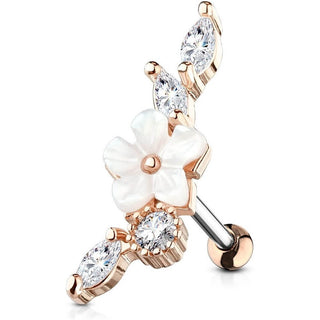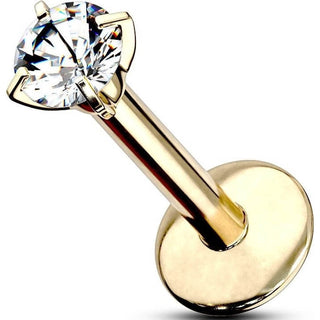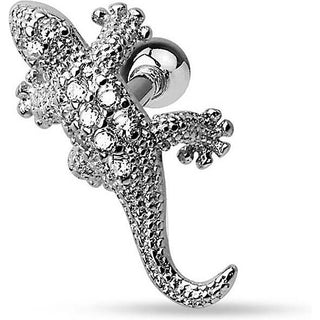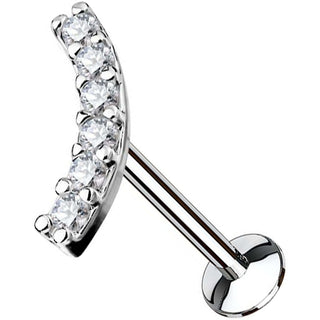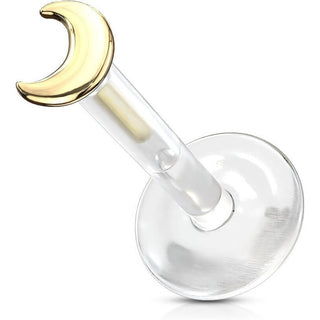Ear Piercing
Discover over 600+ unique ear piercings at our shop, made from premium materials like Titanium and 316L Surgical Steel. Enjoy our competitive prices and excellent customer service.
Ouerpiercing Buttek
Mir bidden eng breet Palette vun d'Inner Conch gëtt zum Beispill duerch e décke Rank accentuéiert an d'Outer Conch stécht besonnesch mat Stecker mat glitzerende Opalsteng oder Zirkonia-Steng eraus. D'Inner Conch bitt besonnesch vill super Looks wéinst de villen verschiddene Aarte vu Piercingschmuck, déi hei méiglech sinn. D'Inner Conch kann mat schmuelen wéi och décke Réng a mat klenge oder groussen dekoréierte Stecker verschount ginn.
Ouer Cuff Piercing
Ouer Cuffs sinn Ouerklammeren, déi um baussenzege Rand vum Ouer befestegt ginn. Si ginn an der gewënschter Positioun um Ouer positionéiert a ginn dann zesummegepresst, bis de Ouer Cuff Piercing sécher um Ouer sinn. Dës Zort Ouerréng erfuerdert kee Piercing-Lach, dofir gi se dacks als Helix Piercing oder Conch Piercing Alternativ benotzt. Dëst ass well Ouer Cuffs souwuel de Schmerz vum Piercing wéi och déi laang Heelungszäit eliminéieren. Ouer Cuffs sinn och eng gutt Iddi fir déi, déi onentschloss sinn, well se Iech erlaaben ze probéieren, ob Dir de Ouerschmuck gär hutt oder net, ier Dir piercéiert.
Vun dënne klenge Cuffs bis zu opfällege Ouerklammeren mat hänkege Ketten a Pendants, gëtt et eppes fir jiddereen. Sou kënnt Dir och Äre Stil diversifizéieren, andeems Dir extravagant Ouer Cuffs en Dag an einfach Ouer Clips den nächsten droen.
Daith Piercing
Den Daith Piercing gëtt duerch d'Knorpelfalz iwwer dem Ouerentree gestach a läit an der Mëtt vum Ouer. De modische Ouerréng gesäit net nëmmen schéin aus, mee soll och géint Migräne hëllefen. Dëst ass well en Akupunkturpunkt duerch dës Plaz leeft, wat e relaxéierende Effekt huet wann et stimuléiert gëtt a sou och Migräne soll entlaaschten. Dëst gouf net wëssenschaftlech bewisen, mä laut Berichter schéngt et fir vill (awer net all) Leit mat Migräne ze funktionéieren. Wann den Daith Piercing Är Migräne net verschwënnt, hutt Dir op d'mannst e coole Piercing.
Industrial Piercing an Orbital Piercing
Den Industrial Piercing an den Orbital Piercing sinn allebéid Ouerréng, déi duerch zwou Plaze um Ouer gestach ginn an dann entweder mat engem laange Barbell-Stéck (Industrial Piercing) oder engem Rank (Orbital Piercing) verbonne ginn. Den Industrial läit uewen um Ouer a gëtt duerch den äusseren an ieweschte Ouer-Rand gestach. Mat dem Orbital Piercing hutt Dir eng grouss Wiel, well dëse Piercing op all Plaze um Ouer gestach ka ginn. Sou kënnt Dir en Orbital Piercing um Ouerläppchen wéi och op all Deel vum Knorpel kréien.
Rook Piercing
Den Rook Piercing gëtt vertikal duerch déi ieweschte, mëttlere Knorpelfalz gestach, och bekannt als Antihelix. Gebuënn Barbells (also Bananen) sinn de gëeegentste Schmuck fir de Rook, well déi liicht gebuënn Stäbchen sech besonnesch gutt un dëse Beräich upassen. Bananen tëscht 8 mm an 10 mm ginn dacks gewielt. Réng sinn grad sou gëeegent fir Rook Piercing wéinst hirer gebuënnter Form, mä dës sollten nëmme als sekundär an Ersatzschmuck benotzt ginn.
Ouerpiercing Materialien
D'Auswiel vum richtege Material fir Piercing ass extrem wichteg, well am Géigesaz zu normalen Bijouen, Piercingen sinn am Kierper an dofir méi empfindlech. Besonnesch fir déi éischt Uwendung ass dat richtegt Material e entscheedende Faktor fir déi problemfräi Heilung vun engem Piercing. Awer och no der éischter Heilungsphas bleift de Piercing-Material wichteg, well mat dem richtege Material Komplikatioune no der Heilung kënne vermeide ginn. Dir fannt méi Informatiounen doriwwer an d'Virdeeler vun den eenzelne Materialien an eisem Piercings no Material Guide.
Chirurgesche Stol Piercing
Chirurgesche Stol ass e populärt Material fir Piercing an bitt verschidde Virdeeler. Den Chirurgescht Stol Ouerpiercing huet eng besonnesch glat Uewerfläch, wat manner Reiwung garantéiert. Chirurgesche Stol kann weder rusten nach verfaarwen an huet dofir eng laang Liewensdauer. Zousätzlech ass Chirurgesche Stol ganz bëlleg an zur selwechter Zäit vun héijer Qualitéit. Leit mat enger grousser Zuel vun Ouerréng wielen dofir dacks dëst Material, fir d'Käschte vun hiren Ouerréng niddereg ze halen.
Titan Piercing
Titan Ouerpiercing ass ee vun de populäersten Materialien fir Ouerréng. Besonnesch fir Leit mat enger Nickelallergie ass dëst Material interessant, well Titan 100% nickel-fräi ass an dofir eng komplett sécher Wiel ass. Wéinst dëser Eegenschaft gëtt Titan och dacks vu Piercer als éischt Schmuck fir eng glatt Heilung benotzt. Well Titan vill aner positiv Eegeschafte bitt nieft senger nickel-fräier Zesummesetzung, sinn Piercingen aus dësem Material e bësse méi deier. Wéi och ëmmer, vill Leit akzeptéieren de méi héije Präis, well se héich Qualitéit fir hiert Geld kréien.
Echt Gold
Piercingen aus Echtgold si besonnesch héichqualitativ an héich kompatibel. Gold-Piercingen si aus 14 oder 18 Karat Gold, well méi héich Karaten ze mëll fir Piercingen an ufälleg fir Kratzer sinn. Gëlle Ouerpiercing mat dem richtege Karat sinn haltbar an hunn eng laang Liewensdauer. Oueren, déi mat Gold-Piercingen dekoréiert sinn, gesinn besonnesch elegant aus wéinst dem héich poléierte Edelmetall. D'wäertvoll Material ass dofir eng gutt Investitioun, déi Iech laang Freed gëtt.
Bioflex Piercing / Plastik
Piercingen aus Bioflex Piercing oder Plastik sinn gutt fir d'Oueren, well d'Material bequem ze droen ass, extrem flexibel ass an eng glat Uewerfläch huet, déi anti-allergesch ass. PFTE Stäbchen mat Usätz aus anere Materialien wéi Gold oder Titan gi haaptsächlech fir d'Oueren benotzt. Dëst huet de Virdeel, datt de Piercing-Lach duerch de Plastiksstéck geschützt ass, ouni de Look vun engem Metall-Piercing ze verléieren.
Ouerpiercing Schmuck
No der Heilung vun Ärem Ouerréng kënnt Dir endlech den éischte Piercing wiesselen an Äert Piercing mat Kierperschmuck a ville verschiddene Formen a Faarwen wéi Gold, Roségold oder Sëlwer dekoréieren. Nieft den klassesche Ouerstecker an Ouerréng kënnt Dir och Är Oueren mat Barbells, Hufeisen oder Labret Piercing dekoréieren, zum Beispill.
Barbell Piercing, och Schmuck-Hantelen genannt, besteet aus riichte Stäbchen mat zwou Kugelen un den Enden. Dës Zort Piercing-Schmuck gëtt fir Industrial Piercing bevorzugt. D'Stécklängt vun der Hantel sollt ongeféier 30 mm bis 50 mm fir den Industrial sinn. Kleng Barbells mat ongeféier 6 mm bis 8 mm kënne z.B. fir d'Helix Piercing oder den Tragus Piercing benotzt ginn. Gebuënn Barbells oder Bananen sinn eng speziell Form vu Barbell. Si si gutt gëeegent fir Snug Piercing a Rook Piercing wéinst hirer liicht gebuënnter Form.
Hufeisen-Piercing (oppene Rank mat zwou Kugelen) a zouene Réng wéi CBR-Réng oder Segmentrank oder Segment Clicker si besonnesch populär fir Ouerréng wéi d'Helix Piercing. Wéi och ëmmer, dës Zorte vu Réng kënnen och fir déi meescht aner Ouerréng-Typen benotzt ginn, souwäit et anatomesch méiglech ass. D'Villfalt vu Rénggréissten an Designen mécht Piercingrank eng populär Wiel fir Ouerréng.
Labret Piercing kann benotzt ginn fir bal all Ouerréng ze verschléissen. Well Labret Piercing a villen schéine Motiver a Motiver verfügbar sinn, ass d'Auswiel an och d'Méiglechkeet de Ouerschmuck ze personaliséieren grouss.
Flesh Plug, Flesh Tunnel an Expander gi benotzt fir Ouerlächer ze verbreeden an hunn en aussergewéinleche Look. Si si ganz opfälleg an dofir gëeegent fir Leit, déi gär mat hirem Kierperschmuck Opmierksamkeet zéien.
Dir kënnt all dës verschidden Zorte vun Ouerschmuck an eisem Shop an héichqualitative Materialien wéi Chirurgesche Stol, Gold (14 Karat) oder Titan zu faire Präisser kafen.
Ouerpiercing Trends
Ouerréng sinn esou populär bei Promi an Influencer ginn, datt et schwéier ass, d'Moudeszene ouni si virzestellen. Dementspriechend ginn et Joer fir Joer cool Ouerréng, déi d'Ouer mat de leschte Kierperschmuck verschléissen. Hei drënner hu mir fir Iech déi 5 meescht gesichte Ouerréng-Trends am Joer 2022 zesummegestallt.
Curated Ear
Den "Curated Ear" bleift ee vun de waarmsten Ouerréng-Trends. Mat der Curated Ear ginn e puer Ouerréng matenee kombinéiert, fir schéin a koordinéiert Looks ze kreéieren. De Virdeel ass, datt Dir Är Ouerréng individuell no Ärem Goût gestallte kënnt. Zum Beispill kënnt Dir eng ästhetesch Curated Ear mat e puer Ouerläppchen Piercingen, dem Daith Piercing an der Helix Piercing kreéieren. D'Curated Ear kann weider personaliséiert ginn duerch d'Kombinatioun vu verschiddene Ouerschmuck wéi filigran Stecker oder Réng mat ongewéinleche Motiver. Sou gesinn keng zwou Oueren d'selwecht aus.
Flat Piercing
Den Flat-Piercing läit an der Mëtt vun der flaacher Säit vum Ouer. Dës Zort Ouerréng ass relativ nei, awer genéisst nach ëmmer grouss Popularitéit. Mat dem Flat-Piercing kënnt Dir tëscht verschiddene Piercingen mat klenge Stecker oder engem groussen Ouerstecker wielen. Béid Varianten bidden verschidde Looks a gesinn besonnesch gutt aus an der Kombinatioun mat anere Ouerréng wéi Helix Piercing oder Tragus Piercing. De Virdeel vum Flat-Piercing ass déi relativ kuerz Heelungszäit. Am Géigesaz zu anere Knorpel-Piercingen dauert dëst nëmmen ongeféier 6-8 Wochen.
Forward Helix Piercing
Eng interessant Variant vum Helix Piercing, déi dëst Joer populär ass, ass de Forward Helix Piercing (och Anti Helix genannt). Dat Besonnesches un dësem Piercing ass, datt et uewen um baussenzege Rand vum Ouer gestach gëtt anstatt um baussenzege Rand wéi déi normal Helix. Déi populäersten Piercing-Schmuck fir de Forward Helix sinn kleng, dënn Stecker, déi op dëser schmueler Fal um Ouer gutt ausgesinn. Den Triple Forward Helix, wou dräi Piercingen op dëser Plaz plazéiert ginn, gesäit besonnesch attraktiv aus.
Daith Piercing
Den Daith Piercing ass ee vun de schéinste Ouerréng. An der Kombinatioun mat engem ornate Segment Clicker entfalt dëse Piercing säi vollt Potenzial a gesäit opfälleg schéin aus. Mä déi, déi e méi diskret Look léiwer, kënnen och dëse Piercing droen, well och einfach Ouerréng diskret op dëser Plaz erausstiechen.
Inner Conch Piercing
Ee vun de meescht gesichte Ouerréng ënnert Influencer an Promi ass ouni Zweiwel den Inner Conch Piercing. Kombinéiert mat engem Rank mat enger héijer Stéckdéckt a glitzerende Steng, zitt dëse Piercing direkt d'Aen un. Mat dem richtege Schmuck, deen Dir an eisem Shop zu onschlagbare Präisser fannt, wäert Dir all Aen op Äert Ouer zéien.
Ouerpiercing vun engem Ouerréng
Ouerréng sollten ëmmer an engem Piercing-Studio vun engem qualifizéierte Piercer gestach ginn. Och wann d'Piercing bei engem Bijoutier fréier üblech war, ass dat fir en Ouerréng net méi déi bescht Wiel, well Bijoutieren, am Géigesaz zu Piercer, net speziell fir Piercing trainéiert sinn. Sou sinn Piercer vill méi kennt an dësem Beräich an dofir fäeg, seriöFeeler ze vermeiden, déi duerch Mangel u Wëssen entstoe kënnen.
Beim Piercing vun engem Ouer ginn verschidde Techniken benotzt, ofhängeg vum Typ vum Piercing. Am Fong gëtt ëmmer eng speziell Piercing-Nadel, e sougenannte Kanül, benotzt. Je no Piercing benotzt de Piercer Zangen, fir d'Géigend gutt ze gräifen an genee op der markéierter Plaz ze stiechen. Eng aner Piercing-Technik ass d'Benotzung vun engem Empfangsréier. Dëst ass eng Zort Schutzréier, déi hannert dem Ouer oder hannert der ze piercéierender Géigend beim Piercing gehale gëtt. Et fänkt d'Nadel sécher no dem Piercing a verhënnert d'versehentlech Piercing vum Nopeschgewebe op méi schmueler Plazen wéi dem Daith Piercing oder Tragus Piercing. D'Schutzréier schaaft e Géigendrock beim Piercing, wat d'Piercing méi einfach mécht.
De Basisprozess fir e Ouerréng ze piercéieren ass net vill anescht wéi dee vun all aneren Typ vu Piercings. Déi gewënschte Géigend gëtt gutt desinfizéiert a vum Piercer markéiert. D'Gewebe gëtt mat de Fanger, Zangen oder engem Empfangsréier wéi uewen beschriwwen gehalen oder ënnerstëtzt. De Piercer stécht dann d'Piercingplaz mat enger steriler Nadel an enger schneller a glatter Beweegung. De Piercing-Schmuck gëtt dann normalerweis mat Hëllef vun enger Plastikkanül duerch de Piercing gezunn a sécher zougemaach. De Piercing ass fäerdeg mat der spéiderer Botzen vun der frëscher Wonn.
D'Präisser fir d'Piercing vu verschiddene Ouerréng variéiere staark a hänke vum Typ vum Piercing of. Jee no Ouerréng an dem Studio bezuelt Dir ongeféier 20 € bis 80 €.
Ouerpiercing Methoden
Nieft dem Piercing ginn et aner Methoden, déi Dir benotze kënnt, fir Äert Ouer ze piercéieren. Fir eng laang Zäit goufen Ouerréng mat engem Ouerréng-Pistoul gemaach. Mëttlerweil ass et awer bekannt, datt d'Piercing mat engem Ouerréng-Pistoul erhebliche Schued verursaache kann. Knorpelgewebe däerf ënner kengem Ëmstänn geschoss ginn, well d'Gewebe dobäi zerdréckt gëtt, wat zu Komplikatioune wéi schwéier Entzündungen oder Wuesstumsféiere kann. D'Ouerläppchen ass manner empfindlech wéinst dem mëllen Gewebe, mä och hei ass d'Stiechen mat enger Nadel ze léiwer. Dëst ass well d'Piercing mat enger steriler Nadel, déi no all Client verworf gëtt, vill méi hygienesch ass wéi d'Schéissen mat engem Ouerréng-Pistoul. Och ass d'Piercing vill manner schmerzhaft wéi d'Schéissen.
Eng aner Method ass d'Punching, wat besonnesch gëeegent ass fir Piercingen op Knorpel. Hei gëtt de Knorpelgewebe mat enger huel Nadel op der gewënschter Plaz erausgestanzt. De Virdeel vum Punching ass déi méi kuerz Heelungszäit. Wärend gestach Knorpel-Piercingen normalerweis 6 - 9 Méint daueren fir ze heelen, brauch e gestach Ouerréng nëmmen ongeféier 2-3 Méint. De Nodeel vum Punching ass awer, datt kee neie Knorpelgewebe no der Entfernung vum Schmuck zréckkënnt. Amplaz kann eng dënn Hautschicht iwwer d'Ouerlach entstoen.
Schmerz a Heilung
Wéinst der grousser Zuel vu méiglechen Ouerréng variéieren och Schmerz a Heelungszäit ofhängeg vum Typ vum Piercing. Piercingen um Ouerläppchen (Ouerläppchen Piercing oder Upper Lobe Piercing) sinn normalerweis net ganz schmerzhaft, well de Piercing duerch mëllt Gewebe geet. Dementspriechend heelen d'Ouerréng séier a ouni Komplikatioune bannent ongeféier 4-8 Wochen.
D'Situatioun ass e bësse méi anescht mat den aneren Ouerréng, déi duerch de Knorpel gestach ginn. Well de Knorpel keng eegen Bluttversuergung huet, dauert d'Heelung vill méi laang a kann souguer bis zu 9 Méint daueren. De Schmerz, deen mat Knorpel-Piercingen assoziéiert ass, ass och däitlech méi héich, well de Knorpelgewebe ganz fest ass an dëst zu engem héije Drockschmerz beim Piercing féiert. De Schmerz hänkt dovun of, wéi déck de Knorpel op der Plaz ass. Jee no Typ vum Ouerréng kann de Schmerz staark variéieren. D'Helix Piercing an Industrial Piercing ginn zum Beispill als ee vun de schmerzhaftste Knorpel-Piercingen ugesinn, wärend den Tragus Piercing vu ville als manner schmerzhaft ugesi gëtt.
Pfleeg
Besonnesch bei Knorpel-Piercingen, déi eng méi laang Heelungszäit hunn, ass de Risiko vun Entzündungen héich. Gewëssenhaft Pfleeg wéi vum Piercer verschriwwen an déi folgend allgemeng Tipps kënnen hëllefen, dëse Risiko ze reduzéieren.
Sou wäit wéi méiglech, probéiert net op dat gestach Ouer ze schlofen an ze vermeiden, de Piercing ze beréieren ausser fir d'Fleeg. Beim Duschen, gitt sécher, datt kee Shampoing op Äert neit gestach Ouer kënnt. Aner Produkter wéi Hoerpray sollten och sou vill wéi méiglech vun Ären Oueren ewech gehale ginn. Dir sollt Är Hoer zou halen, op d'mannst fir déi éischt puer Wochen, soss kënne se liicht un Ärem Ouerréng hänken bleiwen. Beim Benotze vun Kopfhörer an beim Telefonéieren, sollt Dir op dat ongestach Ouer wiesselen. Ënner kengem Ëmstänn sollt Dir Äre éischte Piercing ewechhuelen, ier et komplett geheelt ass, soss wäert de Piercing direkt zréck wuessen.
Risiken vermeiden
Wéi bei aneren Zorte vu Piercing, gëtt et d'Méiglechkeet, datt Risiken mat Ouerréng optrieden. Dëse Sektioun erzielt Iech, wat dës Risiken sinn a wéi Dir se ënner Kontroll hale kënnt.
Bei Knorpel-Piercingen sinn liicht Drockgefiller normal, souguer e puer Deeg no dem Piercing, well de Piercing nëmmen dat fest Knorpelgewebe verdrängt an et net ewechhuelen wéi beim Punching. Liicht Schwellung vun der gestach Géigend an e liichte Jucken direkt no dem Piercing sinn och normal. Wann d'Reaktioun awer méi schwéier ass oder wann Dir Péng fillt, sollt Dir alarméiert sinn, well et kéint eng Entzündung oder Infektioun sinn.
Infektiounen kënnen optrieden, wann d'Hygiene beim Piercing oder bei der Fleeg vun der gestach Géigend net genuch ass. Si manifestéiere sech als schwéier Rötung, giel oder brong Eeter a eng Erwiermung vun der gestach Géigend. Bei dëse Symptomer sollt de Dokter direkt konsultéiert ginn, fir weider Komplikatioune ze vermeiden. Allerdéngs kann dat meescht et mat grëndlecher Recherche, suergfälteger Auswiel vun engem erfuerene Piercer an richteger Fleeg vermeide ginn.
Allergien kënnen och e bedeitende Risiko bei Ouerréng sinn a kënnen Rötung, Jucken a Hautausschléi verursaachen. Wann Allergien wéi Latex oder Nickelallergien am Viraus bekannt sinn, ass et wichteg, de Piercer z'informéieren. Hien oder si wäert dann entspriechend Ännerungen während dem Piercing-Prozess maachen, sou datt d'Allergie de Piercing-Prozess an d'weider Heilung net beaflosst.
D'Bildung vu Wëllfleesch, en Iwwerwuesse vu Gewebe, ass besonnesch heefeg bei Knorpel-Piercingen. Wëllfleesch gëtt normalerweis duerch erhéicht Drock a Reiwung verursaacht. Konsequenterweis kann de Risiko vun dëser iwwerwuessener Gewebebildung och reduzéiert ginn, andeems dës Reiwung vermeide gëtt. Zousätzlech kënnen falsch Fleeg oder falsch Piercing (z.B. duerch d'Benotzung vun der falscher Technik oder Wénkel) och Wëllfleesch förderen. Och hei wäert e qualifizéierte Piercer dëse Risiko sou vill wéi méiglech reduzéieren.









